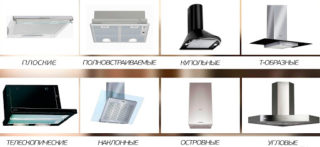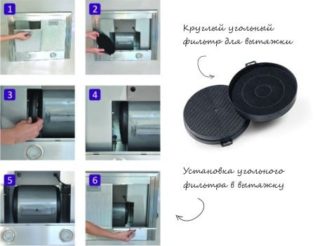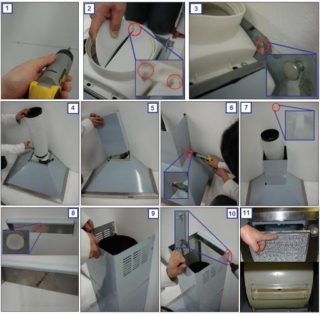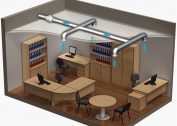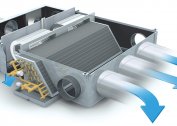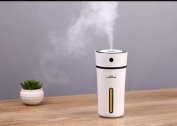The lack of ventilation in the kitchen leads to stagnation of smells from cooking, the gradual deposition of fumes and grease on the walls and ceiling. Exhausting over a gas stove in some cases helps to solve the problem of removing dirty air.
Hood tasks
Hoods for a gas stove perform the functions of:
- remove harmful substances and unpleasant odors from the kitchen air;
- ensure the safety of the gas appliance;
- maintain comfortable conditions in the cook's work area.
During gas combustion and cooking, harmful substances are released into the air, which must be eliminated in a timely manner. Carbon dioxide and carbon monoxide appear when the stove is on. An increased concentration of substances worsens well-being, can cause poisoning. The process of frying foods at high temperatures is accompanied by the release of carcinogens, which, accumulating in the body, lead to cancer.
Cooking is accompanied by the release of various odors, which, spreading through the rooms, are delayed for a long time, soaking the furniture upholstery and clothes. The aromas of several dishes, mixing, can spoil the appetite. Hood will significantly reduce the concentration of odors in the apartment.
The leakage of natural gas from an extinct or off-burner can not always be felt in a timely manner, especially at the time of preparation. An extractor hood will protect against explosion for a while and help to detect a malfunction in a timely manner.
Simultaneous cooking of several dishes causes air heating near the stove, hot steam creates inconvenience. Timely heat dissipation makes work more enjoyable. Built-in lights simplify work at dusk or in the dark.
The principle of operation of devices
Based on the principles of operation of exhaust devices, varieties are distinguished:
- discharge;
- recirculation;
- universal.
The devices of the first type remove harmful substances into the ventilation duct due to draft or by means of a fan. Separate mines are being built in apartment buildings. Channels do not intersect with extracts from bathrooms and living rooms. Among all types of cleaners, the discharge models have the highest performance.
The equipment works in passive or active mode - with the fan turned on or due to natural circulation. This is convenient, as the air in the kitchen is constantly being updated.
According to the current sanitary and fire safety standards, not every house is allowed to install hoods with a forced principle of operation. Before buying a vent hood with a fan, consult with the management company.
During the inspection and maintenance of the gas stove, gas service employees have the right to issue an order to dismantle the forced circulation device. The requirement does not apply to apartments on the upper floors.
Recirculation models are equipped with filters. Air passing through the device is cleaned of harmful impurities. Connection to the ventilation duct of the staircase is not provided. An important drawback of recirculation models is the need to replace or rinse filter elements, which entails some operating costs.
The filters of the first stage, catching fat, are non-woven, paper, sinteponovye - they are disposable and must be replaced 5-6 times a year.Acrylic options can be washed several times in the dishwasher. The service life is limited to 1.5 - 2 years and depends on the intensity of use. Carbon filter elements are installed, as a rule, in universal devices working for air removal and filtration.
Combined devices operate in two modes at the same time or there is the opportunity to use one of them. The devices are powerful and provide maximum air purification.
Criterias of choice
Before buying, hoods assess individual needs. The choice is influenced by:
- geometric dimensions of the hob;
- dome shape and installation method;
- dimensions of kitchen furniture;
- the presence of ventilation shafts into which it is permissible to connect the hood;
- specifications;
- additional functions.
Each of the parameters is taken into account individually.
Dimensions
The width and depth of the hood should be equal to or slightly larger than the size of the gas stove. In this case, rising hot air and steam will be completely removed from the room or filtered.
Considering the dimensions of kitchen furniture is important for aesthetic perception. Hoods produce various models - this makes it easier to choose.
If the use of hoods with fans is prohibited in the house, you will have to install a recirculation model.
An important technical characteristic is the performance of the electric motor.
The Code of Rules 54.13330.2016 requires a minimum air exchange of 100 m3 / h for rooms with a gas stove - you should choose a hood model with a suitable fan.
The form
In the external form of the model there are:
- domed;
- flat;
- T-shaped;
- telescopic;
- inclined;
- angular.
The dome version occupies more area, but completely covers the hob.
Flat most often are recirculation hoods.
Telescopic models make it possible to increase the area of collection of polluted air due to the extendable section. When folded, models are perceived as an interior detail.
A variety of telescopic hoods are domino models, which are cut vertically into the countertop and extended as necessary.
Convenient types of the device are convenient in operation. The front edge is raised up so as not to interfere with cooking.
Placement Method
The most common wall hoods that are mounted on a wall above a gas stove.
Island models are called that are located in the center of the room.
Corner options are convenient in small-sized kitchens when it involves planning.
Additional functionality
In addition to performance, when buying, pay attention to other characteristics:
- the presence of illumination of the working area;
- type of control, mechanical or electronic;
- noise level during fan operation;
- case materials.
Manual control with keys or buttons is more reliable. The electronic device allows you to select the required operating modes, for example, you can turn on the timer and the device will turn off by itself. This allows you to calmly leave home or go to bed without worrying about the fan working continuously.
Usually, when buying, you can turn on your favorite model in the window. The passport of the device indicates the noise level, which should not exceed 35 dB. It is uncomfortable to be in a room with a loudly working device.
Pay attention to what the device body is made of. Enamelled metal is easily cleaned of dirt and dust, you can wash it with any household tool. Models are distinguished by low cost. Stainless steel hoods are attractive in appearance, and the thickness and elasticity of the material allows you to create cases of various shapes.As you operate, you will need cleanings, as the surface gradually darkens. The cost is higher than dyed products. Copper, brass, bronze are used in design projects, hoods are sold at a high price. You will need to maintain the surface in good condition with special cleaners.
Tempered glass best meets hygiene requirements. Combinations with non-ferrous metals distinguish models of the highest price category.
Plastic housings are used in recirculation hoods. The material is subject to deformation from heat.
General installation rules
Before installation, you should familiarize yourself with the manufacturer's recommendations, which are necessarily attached to the product passport.
There are several general rules:
- the minimum distance from the hob to the lower cut of the hood is 65 cm;
- optimally retreat 75-80 cm, which eliminates head bangs during cooking;
- air ducts use a constant shape or corrugated, which can be bent;
- there are no strict requirements for the location of air ducts; they can be hidden in cabinets;
- when buying, pay attention to the geometry of the outlet pipe, the channel must correspond to it.
The industry produces ducts made of plastic. Before buying, it is important to find out if it is intended for transporting hot gases.
Installation height cannot be underestimated, especially for models with filters. At close range, excessive heating of the electric motor occurs, which reduces its resource. Heavily contaminated oil filters can catch fire from high temperatures.
Increasing the distance is undesirable - the suction power may not be enough for high-quality operation of the device.
Please note that during operation, the corrugated channels may emit increased noise from vibration. If the hood is far from the entrance to the ventilation shaft, it is better to use ducts of a constant configuration.
Step by step instructions
Each type of hood has features in the installation, compliance with which allows you to use the device most efficiently.
Installation of recirculation models
Installing hoods that do not require connecting ducts is the easiest.
The operation algorithm is as follows:
- Measure and mark on the wall the location of the lower cut of the hood.
- Spend the vertical axis of the center of the device.
- Drill holes are marked using a template or applying a hood to the desired location.
- Drill holes for fasteners.
- Mount dowels or anchors.
- The configuration of the upper holes, as a rule, implies hanging the hood on the screws already screwed in, hang the device.
- Screw the additional lower self-tapping screws (anchor nuts).
- Mount the power outlet.
- Install a removable filter.
They complete the installation with a test run and testing in all the prescribed modes.
The installation order does not change for tilted or extendable models.
Installation and connection of diversion type models
For diverting models, the operation algorithm is approximately the same as described above. After performing paragraph 8 of the previous algorithm, the ducts are connected.
For this:
- Carry out the necessary measurements, draw a diagram.
- Pick up the details of the required size, knee, turns.
- To output the duct, a grill is purchased.
- The pipe is attached to the exhaust pipe and is gradually mounted towards the ventilation shaft.
- The channels are fixed to the wall with the help of clamps of a suitable size.
When installing the duct, joints at sharp angles must not be allowed - this causes turbulence and a reverse air flow. Take into account that each turn reduces productivity by about 10%.
When buying pipes of constant cross-section (not corrugated), preference is given to round products.In them less than in rectangular, dust and dirt accumulate.
To remove air from the kitchen, it is forbidden to use channels designed for ventilation of bathrooms and living rooms. If there is no exact information on the purpose of the mines, they turn to the specialists of the management company.
Placement of island appliances
The most difficult thing is to correctly install the models located in the center of the kitchen - even small inaccuracies in the layout and inaccurate installation can spoil the attractive appearance of the structure.
Before installation, it is necessary to carefully study the features of the model and the recommendations of the manufacturers. The devices are attached to the ceiling, so if it is suspended, provide for the installation of extension brackets.
The general installation principle is as follows:
- Using the laser level or plumb, carefully center the center of the future hood on the ceiling.
- Mount the mounting bracket, it is important to choose accessories that can withstand the weight of the future design.
- Lead to the installation site electrical wires.
- Guides for the hood duct are fixed to the bracket, having previously precisely calculated their length.
- Place and screw the fan unit to the bracket.
- Connect the fan and control unit to the network.
- Put on and fasten on guides a decorative casing.
- Install the filter unit.
Finish the installation by testing in all provided modes. If necessary, eliminate rattling and other identified shortcomings.
Features of installation in private homes
In individual housing, you can install any type of device.
If ventilation ducts are not provided by the project, cut a hole into the street or under the roof.
Otherwise, the installation process is the same as in the apartment. At the final stage, it is important to carry out hydro and thermal insulation of the duct outlet points.
How to get around the gas pipe
In the houses of the old construction, a situation is common when a gas pipe interferes with hanging the hood over the stove.
There are several ways to solve the problem:
- Contact the gas supply organization to transfer the pipe. The option is long and not always feasible due to existing rules. Costs can range from 10,000 rubles, depending on the region.
- Move the gas stove using a hose of the required length.
- Attach wooden blocks of the required thickness to the wall above and below the pipe. Installation is carried out on a prepared base. It is necessary to be prepared for the fact that claims may be from a gas supplying organization.
- Use suitable brackets. The rubber gasket for the hood will significantly reduce noise from vibration when the motor is turned on.
The installation of the hood refers to the work that you can do yourself - no special skills will be required. It is important to follow the installation rules, then the effect will be noticeable immediately.





